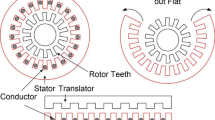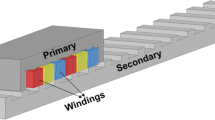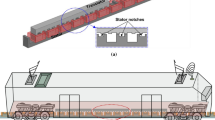Abstract
Linear Motors forms an integral part of propulsion systems used in linear motor propelled high-speed transport systems. Generally, motors such as linear induction and linear synchronous are preferred worldwide for these applications. In spite of showing the immense capabilities, linear switched reluctance motor (LSRM) is still under research for applications in high-speed systems. This paper focuses on a LSRM with enhanced propulsion force for the application in high-speed transportation systems. It has a linear structure with moving translator for direct force transmission and two-teeth in each stator pole to attain better force performance. In the proposed motor, translator teeth count is more as compared to the stator teeth count. A 6/16 LSRM with three- phase split-teeth stator has been proposed. The performance of the proposed 6/16 LSRM has been compared with 6/4 and 6/8 three-phase conventional motors to highlight the improvements in the proposed motor. The paper also modifies the proposed 6/16 LSRM into 12/32 configuration to analyse its force ripple reduction capability. The performance of the 6/16 is compared with the 12/32 LSRM. All the motors are modelled and analysed in 3D with the help of finite-element analysis (FEA). The paper optimizes the 6/16 LSRM using parameter based cumulative deterministic optimization algorithm (PBCDOA) to maximize its propulsion force. The FEA based analysis shows better force performance for the proposed motor.





















Similar content being viewed by others
References
Zhou L and Shen Z 2011 Progress in high-speed train technology around the world. Journal of ModernTransportation 19: 1–6
Lee H W, Kim K C and Lee J 2006 Review of maglev train technologies. IEEE Transactions on Magnetics 42: 1917–1925
Uzuka T 2011 Trends in high-speed railways and the implications on power electronics and power devices. In: IEEE 23rd International Symposium on Power Semiconductor Devices and ICs, San Diego, CA, pp. 6–9
Boldea I 2013 Linear Electric Machines, Drives and Maglevs Handbook. Boca Raton: CRC Press, pp 55–207
Wang D H, Shao C L, Wang X H and Chen X J 2016 Design and performance comparison of a bilateral yokeless linear switched reluctance machine for urban rail transit system. In: Vehicle Power and Propulsion Conference (VPPC), Hangzhou, pp. 1–5
Wang D, Wang X and Du X F 2017 Design and comparison of a high force density dual-side linear switched reluctance motor for long rail propulsion application with low cost. IEEE Transactions on Magnetics 53: 1–4
Liu C T, Su K S and Chen J W 2000 Operational stability enhancement analysis of a transverse flux linear switched-reluctance motor. IEEE Transactions on Magnetics 36: 3699–3702
Krishnan R 2001 Switched Reluctance Motor Drives. Ed: Irwin J D. Boca Raton: CRC Press, pp 107–188
Cao G, Fang J, Huang S, Duan J and Pan J F 2014 Optimization design of the planar switched reluctance motor on electromagnetic force ripple minimization. IEEE Transactions on Magnetics 50: 1–4
Zou Y, Cheng K E, Cheung N C and Pan J 2014 Deformation and noise mitigation for the linear switched reluctance motor with skewed teeth structure. IEEE Transactions on Magnetics 50: 1–4
Wang Y and Hao W 2018 Torque impulse balance control for multi-tooth fault tolerant switched-flux machines under open-circuit fault. Energies 11: 1–21
Zhu J, Cheng K W E, Xue X and Zou Y 2017 Design of a new enhanced torque in-wheel switched reluctance motor with divided teeth for electric vehicles. IEEE Transactions on Magnetics 53: 1–4
Prasad N, Jain S and Gupta S 2019 Design and analysis of a new improved force linear switched reluctance motor for transit application. IETE Journal of Research. https://doi.org/10.1080/03772063.2019.1676664
Author information
Authors and Affiliations
Corresponding author
Rights and permissions
About this article
Cite this article
Prasad, N., Jain, S. & Gupta, S. Comparative analysis of new improved force split-teeth Linear Switched Reluctance Motor for high speed transit systems. Sādhanā 45, 147 (2020). https://doi.org/10.1007/s12046-020-01389-z
Received:
Revised:
Accepted:
Published:
DOI: https://doi.org/10.1007/s12046-020-01389-z




